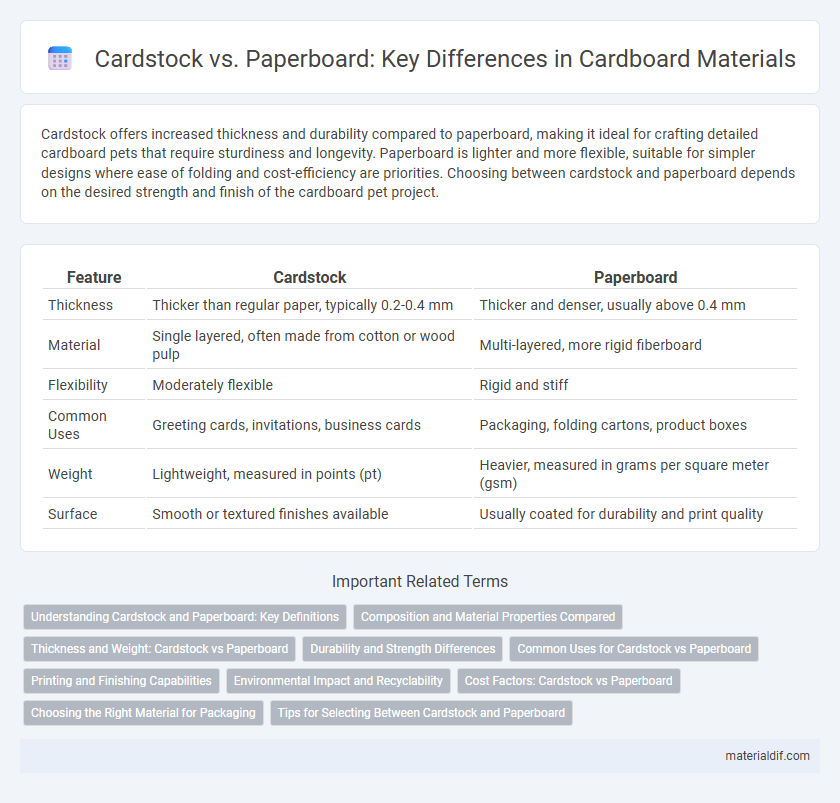Cardstock offers increased thickness and durability compared to paperboard, making it ideal for crafting detailed cardboard pets that require sturdiness and longevity. Paperboard is lighter and more flexible, suitable for simpler designs where ease of folding and cost-efficiency are priorities. Choosing between cardstock and paperboard depends on the desired strength and finish of the cardboard pet project.
Table of Comparison
| Feature | Cardstock | Paperboard |
|---|---|---|
| Thickness | Thicker than regular paper, typically 0.2-0.4 mm | Thicker and denser, usually above 0.4 mm |
| Material | Single layered, often made from cotton or wood pulp | Multi-layered, more rigid fiberboard |
| Flexibility | Moderately flexible | Rigid and stiff |
| Common Uses | Greeting cards, invitations, business cards | Packaging, folding cartons, product boxes |
| Weight | Lightweight, measured in points (pt) | Heavier, measured in grams per square meter (gsm) |
| Surface | Smooth or textured finishes available | Usually coated for durability and print quality |
Understanding Cardstock and Paperboard: Key Definitions
Cardstock is a thick, durable paper often used for crafting, invitations, and business cards, typically measuring between 50 lb to 110 lb in weight. Paperboard, also known as cardboard, is a heavier, more rigid material made from multiple layers of pulp, commonly used for packaging and structural applications. Understanding these key definitions helps distinguish cardstock's flexibility and lightweight properties from paperboard's sturdiness and bulk.
Composition and Material Properties Compared
Cardstock generally consists of thick, stiff paper made from cellulose fibers, offering moderate rigidity and smooth texture, ideal for crafting and printing. Paperboard, often thicker and denser, is composed of multiple layers of recycled fibers or pulped wood, providing enhanced durability and structural strength suitable for packaging. The higher grammage and layered composition of paperboard result in superior stiffness and resistance to bending compared to cardstock.
Thickness and Weight: Cardstock vs Paperboard
Cardstock is thicker and heavier than standard paper, typically ranging from 50 lb to 110 lb cover weight with a thickness between 0.2 mm to 0.4 mm, making it ideal for business cards, postcards, and invitations. Paperboard, however, is generally thicker and denser than cardstock, often exceeding 0.4 mm in thickness and used in packaging applications like cereal boxes and folding cartons due to its greater durability. The significant difference in thickness and weight between cardstock and paperboard determines their distinct functional uses in printing and packaging industries.
Durability and Strength Differences
Cardstock offers higher durability and strength compared to standard paperboard due to its thicker, more compact fibers, making it ideal for crafting and printing projects that require rigidity. Paperboard, while also sturdy, typically has more layers and variable thickness, providing greater structural support for packaging and shipping applications. The choice between cardstock and paperboard depends on the required balance of flexibility and robustness for specific uses.
Common Uses for Cardstock vs Paperboard
Cardstock is commonly used for crafting, invitations, business cards, and scrapbooking due to its thickness and stiffness, providing durability and a professional finish. Paperboard finds frequent application in packaging, such as cereal boxes, folding cartons, and product displays, where rigidity and lightweight properties are essential. Both materials serve distinct purposes, with cardstock favored for projects requiring sturdiness without bulk, and paperboard preferred for structural packaging solutions.
Printing and Finishing Capabilities
Cardstock offers superior printing quality with a smooth surface ideal for detailed graphics and vibrant color reproduction, making it perfect for high-end invitations and business cards. Paperboard, while thicker and more rigid, typically has a rougher texture that limits fine print detail but excels in durability and structural applications like packaging. Finishing techniques such as embossing and foil stamping achieve sharper results on cardstock due to its finer fiber composition compared to the coarser makeup of paperboard.
Environmental Impact and Recyclability
Cardstock and paperboard differ significantly in environmental impact and recyclability, with cardstock typically made from a blend of virgin and recycled fibers, allowing easier recycling in standard municipal systems. Paperboard, often thicker and denser, may include coatings or laminations that complicate recycling processes and increase environmental footprint. Choosing cardstock over heavily coated paperboard reduces waste and supports a more efficient recycling cycle, aligning with sustainable packaging goals.
Cost Factors: Cardstock vs Paperboard
Cardstock generally costs more than paperboard due to its higher weight and density, which enhances durability and print quality. Paperboard, being lighter and less rigid, is typically more economical, making it suitable for packaging where cost efficiency is a priority. Production processes and raw material sources also influence price variations between cardstock and paperboard, impacting overall project budgets.
Choosing the Right Material for Packaging
Cardstock is a thick, stiff paper primarily used for greeting cards and invitations, offering smooth surfaces ideal for detailed printing, while paperboard is thicker and more durable, designed for packaging like boxes to provide structural support. Selecting the right material depends on packaging needs: cardstock suits lightweight, decorative packaging, whereas paperboard excels in protecting heavier products during shipping. Evaluating factors such as thickness, durability, printing quality, and cost ensures optimal performance and presentation in packaging applications.
Tips for Selecting Between Cardstock and Paperboard
When selecting between cardstock and paperboard, consider the thickness and rigidity required for your project: cardstock typically ranges from 50 to 110 lb cover weight, making it ideal for invitations and greeting cards, while paperboard is thicker and stiffer, suited for packaging and structural uses. Evaluate the surface finish and printing needs, as cardstock offers smoother surfaces perfect for detailed printing, but paperboard provides durability and resistance for protective packaging. Assess cost-effectiveness by balancing material strength with budget constraints to ensure optimal performance and aesthetics.
Cardstock vs Paperboard Infographic

 materialdif.com
materialdif.com